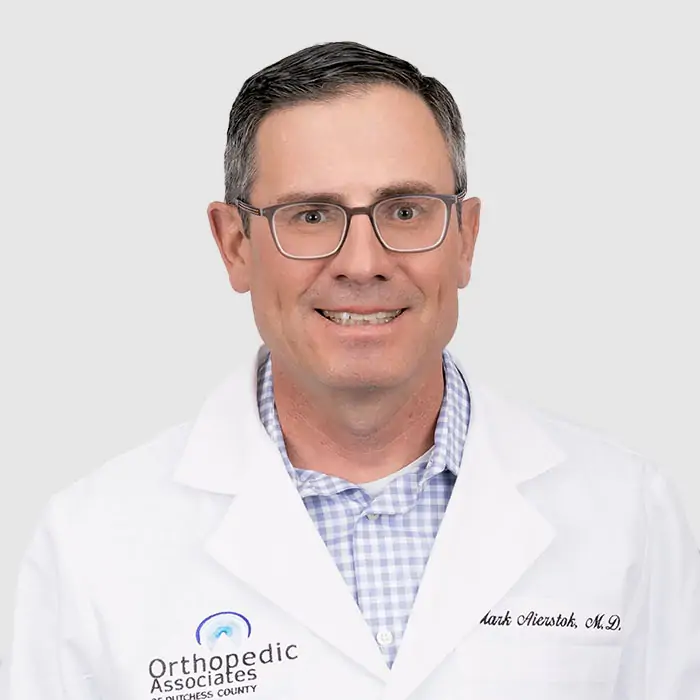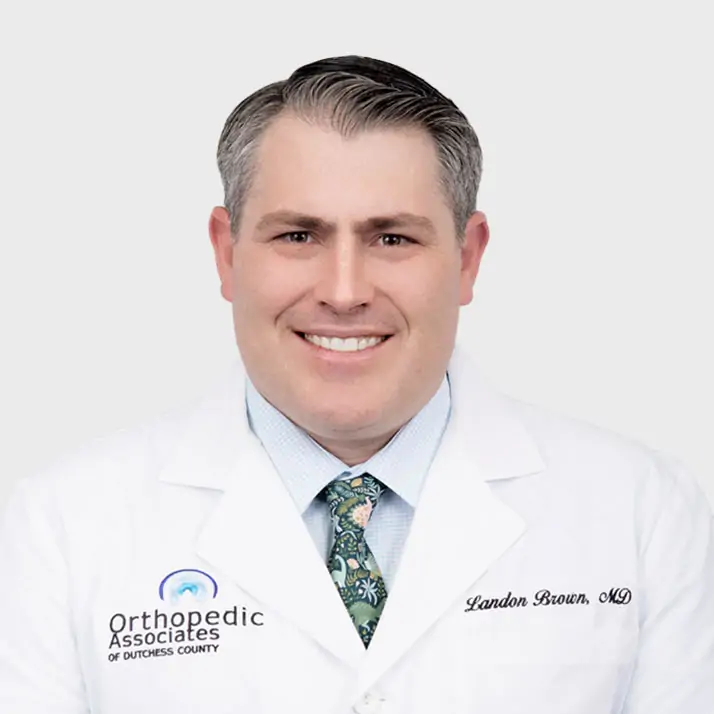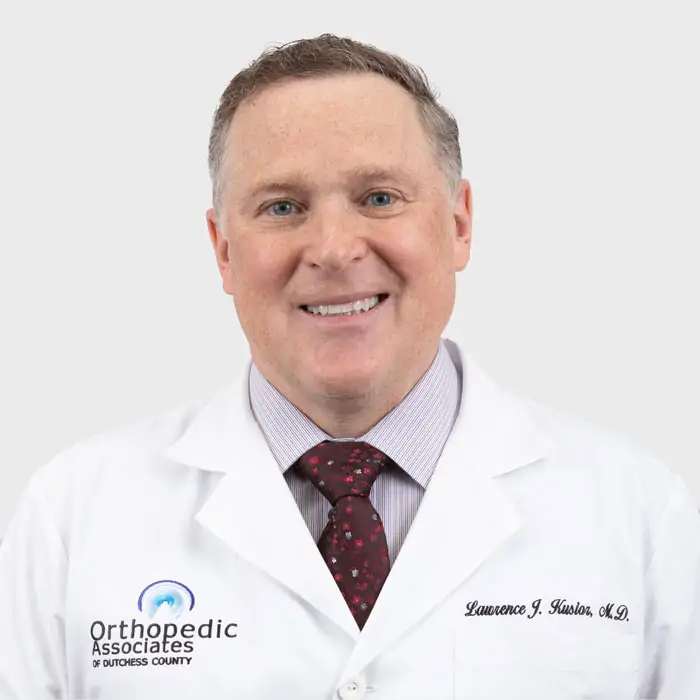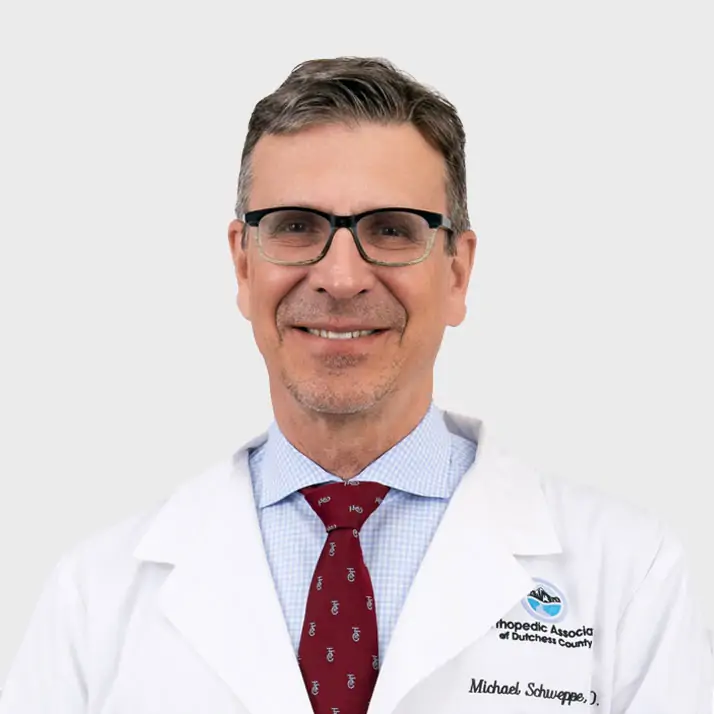Expert Hip & Knee Replacement Surgeons in the Hudson Valley
At Orthopedic Associates of Dutchess County (OADC), our board-certified, fellowship-trained joint replacement surgeons specialize in hip and knee replacement surgery and recovery, offering advanced solutions including minimally invasive joint replacement surgery, robotic-assisted joint replacement surgery, and same-day joint replacement. With convenient locations in Poughkeepsie, Kingston, Hopewell Junction, Rhinebeck, and New Windsor, we provide personalized orthopedic care for patients in the Hudson Valley.
Why Choose Orthopedic Associates of Dutchess County for Joint Replacement?
We know you have choices. We’ve been providing quality joint care to the people of the Hudson Valley for over 45 years. We get to know you and tailor treatments based on your specific goals.
You can rest assured knowing that we offer:
- Fellowship-trained, board-certified orthopedic surgeons: Our surgeons have all completed additional training dedicated to diagnosing and treating knee and hip problems. See our physicians.
- Advanced surgical techniques: Our surgeons are experts at minimally invasive and muscle-sparing approaches. This includes, robotic and technology-enabled surgery, partial knee resurfacing, and direct anterior hip replacement. We stay current with new advancements and incorporate the latest research and evidence into our practice.
- Outpatient joint replacement: Many of our patients go home from surgery the same day. Some may even be a candidate for same-day hip and knee replacement at our outpatient surgery center, The Surgery Center at Orthopedic Associates (SCOA). Learn who is a candidate.
- Seamless surgery and recovery process: With a convenient surgery center, we try to make your joint replacement journey easy to navigate.
Who Needs Joint Replacement Surgery
The most common reason for joint replacement is degenerative arthritis, a condition caused by the gradual wear and tear of cartilage in the hip or knee.
If joint pain is limiting your mobility, work, or daily activities, our team can develop a personalized treatment plan to restore your function. We start with non-surgical options, such as:
• Medications
• Injection therapy
• Physical therapy
OADC also has a dedicated team of non-operative orthopedic specialists to help manage pain and delay or avoid surgery when possible. If these treatments are no longer effective, surgery may be the best option.
The most common reason for joint replacement is degenerative arthritis, a condition caused by the gradual wear and tear of cartilage in the hip or knee.
If joint pain is limiting your mobility, work, or daily activities, our team can develop a personalized treatment plan to restore your function. We start with non-surgical options, such as:
• Medications
• Injection therapy
• Physical therapy
OADC also has a dedicated team of non-operative orthopedic specialists to help manage pain and delay or avoid surgery when possible. If these treatments are no longer effective, surgery may be the best option.
Types of Joint Replacement Surgery We Do
We treat a wide range of people, from athletes with overuse injuries to adults who have been dealing with knee or hip pain for decades. Not everyone needs surgery. But for those who do, we have multiple options.
Hip Replacement Surgery
We remove the damaged ball and socket hip joint and reconstruct it with an artificial joint. Your doctor will discuss which type of surgery is best for you, including:
- Total hip replacement
- Partial hip replacement (also known as hemiarthoplasty)
- Minimally invasive hip replacement
- Outpatient hip replacement for eligible patients
- Anterior hip replacement (an incision in the front)
- Posterior hip replacement (an incision in the back)
We also perform robotically assisted hip replacement surgery, also known as robotic-assisted total hip arthroplasty.
Learn more about hip replacement surgery.
Knee Replacement Surgery
Our surgeons remove the damaged parts of the knee joint and replace it with an implant. Your doctor will discuss if this is an appropriate treatment for your condition, and if you are a candidate for outpatient knee replacement surgery. We perform:
- Total knee replacement
- Partial knee replacement
- Outpatient knee replacement for eligible patients
We also perform robotically assisted knee replacement surgery, also known as robotic-assisted total knee arthroplasty.
Learn more about knee replacement surgery.
Revision Surgery
Hip and knee replacements are generally successful and durable, but some patients will eventually need a revision to correct a problem with an existing hip or knee replacement. Our surgeons perform both revision hip and revision knee replacement surgeries.
We remove the damaged ball and socket hip joint and reconstruct it with an artificial joint. Your doctor will discuss which type of surgery is best for you, including:
- Total hip replacement
- Partial hip replacement (also known as hemiarthoplasty)
- Minimally invasive hip replacement
- Outpatient hip replacement for eligible patients
- Anterior hip replacement (an incision in the front)
- Posterior hip replacement (an incision in the back)
We also perform robotically assisted hip replacement surgery, also known as robotic-assisted total hip arthroplasty.
Learn more about hip replacement surgery.
Our surgeons remove the damaged parts of the knee joint and replace it with an implant. Your doctor will discuss if this is an appropriate treatment for your condition, and if you are a candidate for outpatient knee replacement surgery. We perform:
- Total knee replacement
- Partial knee replacement
- Outpatient knee replacement for eligible patients
We also perform robotically assisted knee replacement surgery, also known as robotic-assisted total knee arthroplasty.
Learn more about knee replacement surgery.
Hip and knee replacements are generally successful and durable, but some patients will eventually need a revision to correct a problem with an existing hip or knee replacement. Our surgeons perform both revision hip and revision knee replacement surgeries.
Featured Videos
Benefits of Same Day Joint Replacement Surgery
Who is a Candidate for Outpatient Joint Replacement Surgery?
Recovery After Surgery
Physicians

- Sports Medicine
Practicing in:
Poughkeepsie, Rhinebeck, and Kingston
- Hip and Knee Replacement
Practicing in:
Poughkeepsie and Hopewell Junction
- Sports Medicine
Practicing in:
Poughkeepsie and Hopewell Junction
- Sports Medicine
Practicing in:
New Windsor, Hopewell Junction, and Poughkeepsie
- Sports Medicine
Practicing in:
Poughkeepsie and Hopewell Junction
- Hip and Knee Replacement
Practicing in:
Poughkeepsie and Kingston
- Hip and Knee Replacement
- Sports Medicine
- Trauma and Fracture Care
Practicing in:
New Windsor
- Hip and Knee Replacement
- Trauma and Fracture Care
Practicing in:
Poughkeepsie, Rhinebeck, and Kingston
- Sports Medicine
Practicing in:
Rhinebeck and Kingston
- Hip and Knee Replacement
Practicing in:
Poughkeepsie, Hopewell Junction, and Rhinebeck


